Moira Butterfield's Blog, page 43
July 16, 2017
Can you teach people how to write a good picture book? By Pippa Goodhart
No and yes.
No, in that there are no clear rules that can be learnt and followed that would fit all good picture books. If you set rules for picture book writing they might include …
Rule 1) Remember that pictures are the key feature of any picture book. That’s why they are called picture books. But then you’d never get a brilliant and successful book such as this –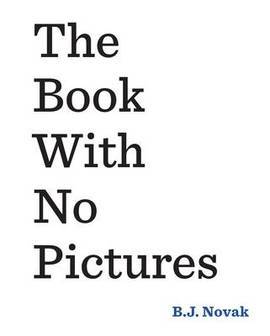 Rule 2) When writing for young children you must always supply a happy ending. But then you’d never get an important honest books such as this –
Rule 2) When writing for young children you must always supply a happy ending. But then you’d never get an important honest books such as this –
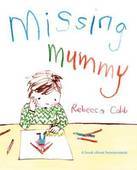
Rule 3) When writing for such a young audience, you must make clear exactly what is happening in the story. And then we’d miss out on genius such as this –

So, no, you can’t neatly teach picture book writing in that didactic sort of way. But you certainly can equip people with necessary knowledge for writing picture books, and also nurture their skills at working with pictures and the book format to convey stories suited to both target audience and market place. I’ve just finished teaching another run of the four week online course in picture book writing that I do via the Writers’ Workshop. On that course, I take students back to thinking about what life was like when they were of the 2-5 year old core picture book audience age themselves. What mattered to them? What did they find funny? I tell them a bit about the often international market for picture books. We think about what a story is, and how best to play it between words and pictures and page turns. We think about writing style, how the text must read out loud pleasingly, the potential pitfalls of writing in rhyme, how dialogue can bring pictures to life, and so on. I asked the participants on the recent course what they thought about that course, and perhaps the most telling comment was this –‘I learned a lot through doing (making mistakes, your comments, having another shot at it).’It’s that having a go, actually doing, and then discussing the results, that develop writing skills far more than teaching 'rules' ever could. It’s what I get from group of writing friends I belong to where we meet regularly, bounce ideas around, read out work and critique it, but the course provides that supportive yet critical community virtually. I love it.Still no guarantee that it will result in a publishing contract and book sales, though!
Do any of you have experiences of courses in picture book writing? Can you think of any other books that clearly disobey the sorts of rules that might be thought to apply to the writing of picture books?
No, in that there are no clear rules that can be learnt and followed that would fit all good picture books. If you set rules for picture book writing they might include …
Rule 1) Remember that pictures are the key feature of any picture book. That’s why they are called picture books. But then you’d never get a brilliant and successful book such as this –
 Rule 2) When writing for young children you must always supply a happy ending. But then you’d never get an important honest books such as this –
Rule 2) When writing for young children you must always supply a happy ending. But then you’d never get an important honest books such as this –

Rule 3) When writing for such a young audience, you must make clear exactly what is happening in the story. And then we’d miss out on genius such as this –

So, no, you can’t neatly teach picture book writing in that didactic sort of way. But you certainly can equip people with necessary knowledge for writing picture books, and also nurture their skills at working with pictures and the book format to convey stories suited to both target audience and market place. I’ve just finished teaching another run of the four week online course in picture book writing that I do via the Writers’ Workshop. On that course, I take students back to thinking about what life was like when they were of the 2-5 year old core picture book audience age themselves. What mattered to them? What did they find funny? I tell them a bit about the often international market for picture books. We think about what a story is, and how best to play it between words and pictures and page turns. We think about writing style, how the text must read out loud pleasingly, the potential pitfalls of writing in rhyme, how dialogue can bring pictures to life, and so on. I asked the participants on the recent course what they thought about that course, and perhaps the most telling comment was this –‘I learned a lot through doing (making mistakes, your comments, having another shot at it).’It’s that having a go, actually doing, and then discussing the results, that develop writing skills far more than teaching 'rules' ever could. It’s what I get from group of writing friends I belong to where we meet regularly, bounce ideas around, read out work and critique it, but the course provides that supportive yet critical community virtually. I love it.Still no guarantee that it will result in a publishing contract and book sales, though!
Do any of you have experiences of courses in picture book writing? Can you think of any other books that clearly disobey the sorts of rules that might be thought to apply to the writing of picture books?
Published on July 16, 2017 16:30
July 10, 2017
This post has no pictures by Juliet Clare Bell
I'm trying a new way of writing. Without writing.
I have a temporary problem with my arms and hands which makes writing and typing very difficult. Fortunately it is only temporary, and I am trying to learn what I can from this enforced difference in the way that I try to write.
As anyone who knows me can testify, I talk a lot. My answer phone messages are always too long and I can take a lot longer to say something than I need. Which is why writing picture books has been a really interesting challenge for me over the years.
I'm a really messy thinker. So for me, I always need to start by brainstorming ideas messily onto a piece of paper. And when I start structuring my picture book, I leave out the vast majority of the original thoughts that I had. But I do need to get them down on paper before I start refining my thoughts. I think best by writing things or typing things down.
Soon I'll be able to write and type things again properly. By the end of the summer, things should be back to normal. And I will be very happy when that happens. But in spite of the frustration of not being able to do what I want to do, it has also been an interesting learning experience.
Here are some things I have learnt.
So much of my thought processes are crystallised by writing things down. I discover what I'm really trying to say by writing it down. Voice recognition software on the phone has been brilliant, but even making to do lists by speaking rather than writing is massively less efficient for me. It's not just that it's slower, it's that I still haven't learnt to think that way. So I miss out loads of things I should be doing.
Writing helps me remember what I'm trying to remember in a way that speaking does not.
Someone told me the other day how my text messages now are like my old answer phone messages! But in fact, text messages and emails are the easiest things to do with voice recognition software if they're just about something practical. And actually, when everything is completely better again soon, I will still use voice recognition software for those kinds of texts and emails- because it is really quick.
Some people are very quick writers. They can say what they want to say really concisely from the start. I, on the other hand, am very slow. And without being able to brainstorm first so I can see what my ideas are in order to structure what I write, I am going to be slower than ever over the next few months...
Brought to you by voice recognition softer with minimal editing and no brainstorming so no structuring.
If you've ever tried new ways of writing, physically, because of an injury or condition, how much has it actually affected what you write?
And has anyone come up with a way of brainstorming without having to use your hands?
Published on July 10, 2017 06:09
July 2, 2017
Ask a Question, Write a Story! • Natascha Biebow
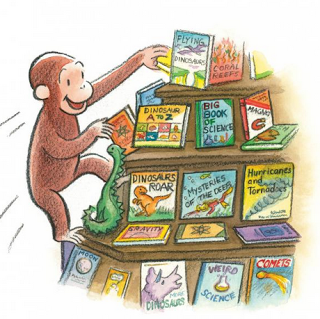 From Curious George Visits the Library by H.A. Ray
From Curious George Visits the Library by H.A. RayChildren often think grown-ups know everything. But I like to think grown-ups know a lot, but still have a lot to learn . . .
Like the eponymous children's book character, Curious George, children are full of wonder and bursting with curiosity. Their enquiring minds are a seemingly bottomless pit of questions that lead to new knowledge and discoveries about the world. Importantly, children are often coming fresh to things so they question WHY things are the way they are. But most adults accept the world as a matter of course. I wonder: do we sometimes get so wrapped up in the business of everyday life, doing stuff, that we pass up the opportunity to STOP, look and learn?
Do we forget to ask questions and stay ahead of the ever-changing world? Are we missing out on the fun of the ‘WHAT IF?’ game, taking a leaf out of the book of children’s curiosity?
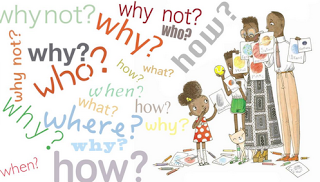 From Ada Twist Scientist by Andrea Beaty and David RobertsI like to think that I learn something new every day. My seven year-old says, “Really, Mommy?”
From Ada Twist Scientist by Andrea Beaty and David RobertsI like to think that I learn something new every day. My seven year-old says, “Really, Mommy?” YES, really! The world is so big and full of the unknown, surely it is possible to learn something new – even if it's just a small thing – every day?!
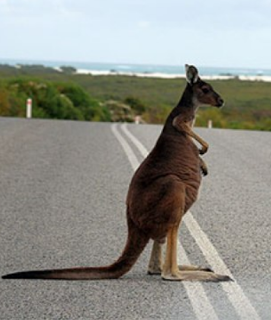 So, for instance, yesterday I learned that the new self-driving cars being developed by Volvo can detect a whole range of wildlife hazards, but bouncy kangaroos are eluding them. Hmmm. Random. But a story is forming. What if . . . ?
So, for instance, yesterday I learned that the new self-driving cars being developed by Volvo can detect a whole range of wildlife hazards, but bouncy kangaroos are eluding them. Hmmm. Random. But a story is forming. What if . . . ? And did you know that we are born to lie, that lying is innately part of human development, like walking and talking?
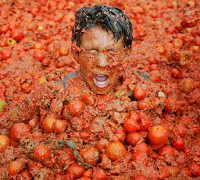 Or that there is a tomato fight in Spain every year?
Or that there is a tomato fight in Spain every year?Or that Henry Ford and Thomas Edison were best friends?
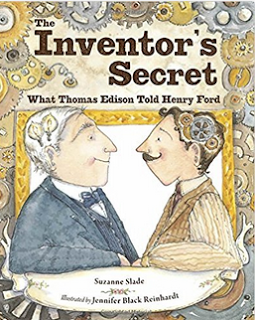
Of course, living with a young person in your house helps. Children are always asking “WHY?” and “HOW COME?” and “WHAT IF?” and saying, “DID YOU KNOW . . .?”
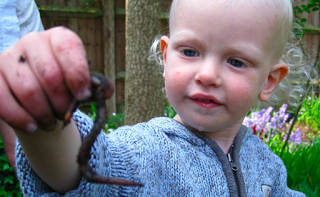 "Oooh a worm - what does it do?"
"Oooh a worm - what does it do?" Sometimes the questions are quite difficult to unpick:
WHO tells your brain what to do – who is the boss?
WHAT is the universe made of?
WHEN can we get a robot to do our chores?
WHY can’t we have cars that go on tram tracks? (Perfect for not using so much petrol!)
HOW COME cigarettes don't cost a million pounds each if they cause cancer?
WHY hasn't anyone invented a flying car yet?!
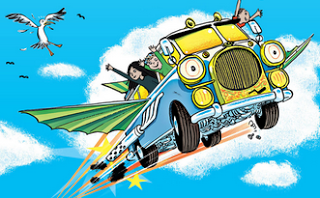 Cover of Chitty Chitty Bang Bang Flies Again illus by Joe Berger
Cover of Chitty Chitty Bang Bang Flies Again illus by Joe BergerThese day when you want to find out something, the first recourse is often to “Ask Google”. Oooh, look, quick answers, facts at the end of your fingertips. What wonder! Hmm, but though the internet may be ‘clever’, it is only as good as the person asking and thinking through the answer.
What does all this have to do with picture books, I hear you ask?
Well, the truth is often stranger than fiction. And this kind of curiosity is a great start for STORY and a fabulous resource for writers.
Non-fiction picture books are a fantastic launching point for our quest to learn about the world and pursue our questions, but facts can also be so much fun when you fictionalize them to knit the story in between. Like in this book:
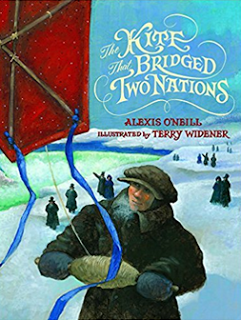
Because story is one of the most powerful ways we can find out about the world,
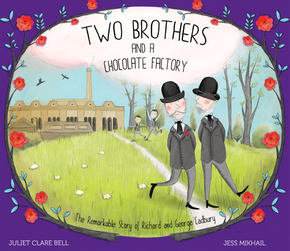
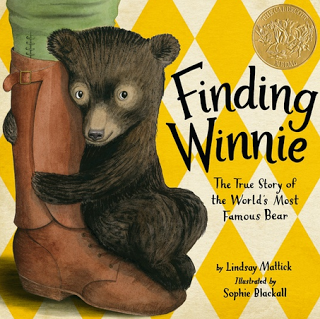
introducing us to ideas and facts that we had perhaps never even considered,
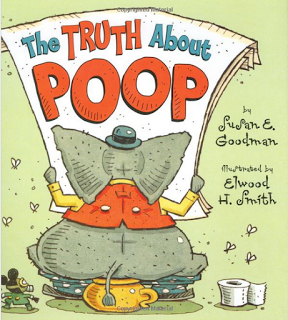

. . . and some stories are so delightfully complex or ambiguous that we just want to keep asking and delving deeper.
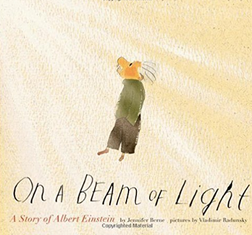
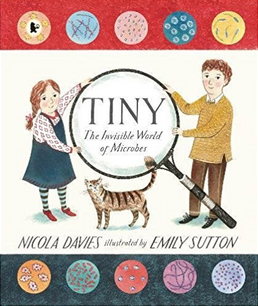
In fact, I'd wager that some of the best stories leave us with more questions than answers . . .
If we all keep on asking WHY the world goes and WHAT makes it go – whether or not the answer can be found on Google or inside a picture book near you – oh, the wonder of the stories we can create!
What will you learn today?!
________________________
Natascha Biebow
Author, Editor and Mentor
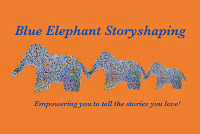 Blue Elephant Storyshaping is an editing, coaching and mentoring service aimed at empowering writers and illustrators to fine-tune their work pre-submission. Check out my small-group coaching Cook Up a Picture Book courses! Natascha is also the author of The Crayon Man (coming in 2019!), Elephants Never Forget and Is This My Nose?, editor of numerous award-winning children’s books, and Regional Advisor (Chair) of SCBWI British Isles.
Blue Elephant Storyshaping is an editing, coaching and mentoring service aimed at empowering writers and illustrators to fine-tune their work pre-submission. Check out my small-group coaching Cook Up a Picture Book courses! Natascha is also the author of The Crayon Man (coming in 2019!), Elephants Never Forget and Is This My Nose?, editor of numerous award-winning children’s books, and Regional Advisor (Chair) of SCBWI British Isles.
Published on July 02, 2017 19:30
June 25, 2017
The Picture Book World Cup • Jonathan Emmett

As well as being a picture book author, I'm a Patron of Reading. A Patron of Reading is a children's author, poet, storyteller or illustrator who partners with a school to encourage and develop a culture of reading for pleasure within that school. I thought I’d use this post to tell you about The Picture Book World Cup, a week-long reading for pleasure project I helped organise at my Patron of Reading school, Asfordby Captain’s Close Primary School in Leicestershire.
The inspiration for the project came from Texas elementary school teacher Diane Fulton. Back in March, Diane sent me the tweet below to tell me that The Princess and the Pig , one of my picture books with illustrator Poly Bernatene, was in competition with 15 other books in her school's Sweet Sixteen Book Challenge.
Decisions... Ss filling out a bracket for our Sweet 16 book challenge! The Princess and the Pig got many votes. @scribblestreet #fmelearns pic.twitter.com/Bf0rx4ByT4— Dianne Fulton (@fultondl7) March 29, 2017
The challenge was a knockout contest, where books were played off in pairings with students voting to decide the winner of each pairing. Diane kept me posted on The Princess and the Pig's progress via Twitter and I was delighted to see it get all the way to the final before its winning streak was finally interrupted by David Ezra Stein’s Interrupting Chicken .
It seemed like such a great idea that I decided to adapt it to use with my patron school.
Diane's wall chart reminded me of the progress charts that newspapers and magazines give out at the beginning of a football World Cup.
 Diane’s Sweet Sixteen wall chart after the first round and a chart from the 2014 Football World Cup
Diane’s Sweet Sixteen wall chart after the first round and a chart from the 2014 Football World CupSo we called our version the Captain's Close Picture Book World Cup and I created this World Cup style progress chart to go with it.
 Each class had a copy of this chart to follow the contest's progress.
Each class had a copy of this chart to follow the contest's progress.I firmly believe that picture books can be enjoyed by all ages – not just preschoolers and infants – and Captain's Close's Literacy Co-ordinator Lisa Gackowska and Headteacher Julia Hancock feel the same way. So we had the whole school vote in our contest, from Reception right the way up to Year 6. The initial groups were age-graded, so the Group 1 books, which were voted on by Reception class, were chosen to appeal to slightly younger readers than the Group 2 books which were voted on by Years 1 and 2. However, as the contest progressed, the age range voting on each match widened. So all of the Key Stage 1 students got to vote on the outcome of Semi-Final 1, while all of the Key Stage 2 Students voted on Semi-Final 2. And the whole school got to vote on the outcome of the final.
One of my aims as a Patron of Reading is to introduce reluctant readers to new books that they'll enjoy reading. Many reluctant readers prefer non-fiction to fiction, so the initial selection contained an equal number of non-fiction and fiction books, with each group starting out with both a non-fiction and a fiction match.
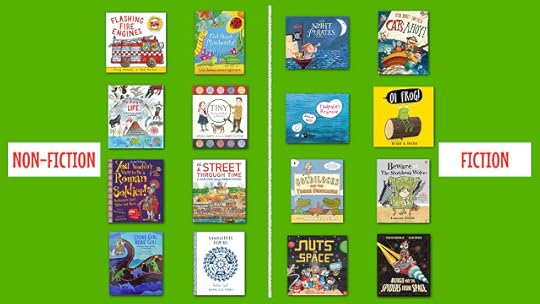
And – following the example of Diane’s US version – each of the initial matches had a different theme.
 Group 2's non-fiction books were both about the Natural World and their fiction books had an Animal Antics theme.
Group 2's non-fiction books were both about the Natural World and their fiction books had an Animal Antics theme.I wanted to encourage students to stray off the beaten path a little, so I tried to avoid books by big name authors like Julia Donaldson (as much as I admire her work). And – to ensure impartiality – I didn’t include any of my own picture books.
I introduced all sixteen books in a special assembly at the beginning of the week. Once the voting had begun, students could follow the progress of all four groups on one of the wall charts, which were updated after each round.
 The School's World Cup corridor display with a wall chart showing the progress of the contest.
The School's World Cup corridor display with a wall chart showing the progress of the contest.After fourteen qualifying matches, the two books that made it all the way to the final were Oi Frog! by Kes Gray and Jim Field and Nuts in Space by Elys Dolan. You can see the results of each qualifying match in the filled in version of the chart below.
 Here's how the chart looked before the final.
Here's how the chart looked before the final.At the end of the week we had another special assembly to finish the contest. I started off by asking students if they had any favourite books that hadn't made it to the final and was pleased to discover that all of the books in the contest had found some new fans.

I’d been tweeting updates on the contest throughout the week and I showed the students some of the responses I’d received from the authors and illustrators of the competing books. You can read some of these tweets in a collection here.
 Finalists Jim Field and Elys Dolan engaged in some pre-match banter on Twitter.
Finalists Jim Field and Elys Dolan engaged in some pre-match banter on Twitter.Then it was time to reveal the winner. The votes for the final had been collected by secret ballot and – to string out the suspense – I announced the results a class at a time. It was a close run contest, with the lead shifting from one book to the other as the votes were counted in. Both books had enthusiastic supporters who broke out into excited cheering whenever their book pulled ahead. I've never had to ask a school audience to settle down so many times!
I'd ordered the results so that it wasn’t clear which book was going to win until the votes from the very last class were counted in.
 Sparrows Class were the last to have their votes counted in.
Sparrows Class were the last to have their votes counted in.But in the end, the winner, by 84 votes to 73 was …
… Nuts In Space, by Elys Dolan!

Congratulations to Commander Moose and his crew for boldly going all the way to World Cup glory and to Elys Dolan for creating such a wonderful book!
My three year tenure as Captain Close’s Patron of Reading ends this term and the Picture Book World Cup wasa great way for me to sign off. So I’d like to give a big THANK YOU to Diane Fulton for letting me steal her idea and another big THANK YOU to Literacy Co-ordinator Lisa Gackowska for doing such a great job of refereeing the project in school.
RUN YOUR OWN PICTURE BOOK WORLD CUP
If you’d like to try running your own Picture Book World Cup I’ve created some PDF progress charts and logos that you can download. There are two sets, one that uses the same books as the Captain’s Close contest described above and a blank template set that you can fill in with your own choice of books.
Click here to download a chart and logo with books.

Click here to download a blank chart and logo.

TimetableHere's a timetable that can be used to run the contest over a week with students split into four groups and an equal number of fiction and non-fiction books. Each group has to read six books and take part in five votes.
MondayIntroduce the contest and all 16 books in morning assembly.Read the two non-fiction books in your group and vote on them.
TuesdayRead the two fiction books in your group and vote on them.Have a quarter final vote between Monday’s non-fiction winner and today’s fiction winner.
WednesdaySemi-Finals: Read the quarter final book chosen by the other group on your half of the chart and then have a vote between that and Tuesday's quarter final winner from your own group.
ThursdayFinal: Read the semi-final book chosen by the other half of the school and then have a vote between that and Wednesday's semi-final winner from your own half of the school.
FridayReveal the winner in assembly!
You can find out more about the Patron of Reading scheme at patronofreading.co.uk

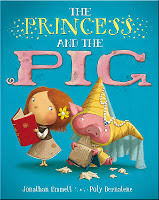 Jonathan Emmett's 'Sweet Sixteen' finalist book was The Princess and the Pig, illustrated by Poly Bernatene
and published by Macmillan Children's Books.
Jonathan Emmett's 'Sweet Sixteen' finalist book was The Princess and the Pig, illustrated by Poly Bernatene
and published by Macmillan Children's Books.
Find out more about Jonathan and his books at his Scribble Street web site or his blog. You can also follow Jonathan on Facebook and Twitter @scribblestreet.
See all of Jonathan's posts for Picture Book Den.
Published on June 25, 2017 22:30
June 18, 2017
Responding to a Call to Action • Chitra Soundar
We’re living in strange times – where dystopia is no longer confined to the pages of a novel. Around us we find fear and insecurity, differences and intolerances turn into political ideology and public policy.
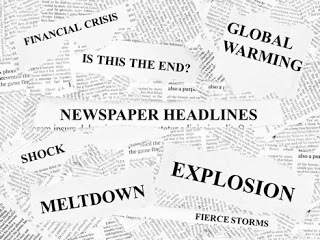
How does a children’s book writer get involved? My readers are wee people who do not understand constitution or right to vote. Many are perhaps not even potty trained. What could I possibly do to bring about change?
Read an interesting discussion in the New York Times - that discusses this very topic.
Good picture books have multiple layers and meanings. While it deals with a child’s emotion in a child’s world from the point of view of a child, it also has an adult reader, often. Many picture books are read aloud by sleepy-eyed parents, novice aunts and uncles doing bedtime as a novelty or grandparents who are amazed at how much books have changed over the years.
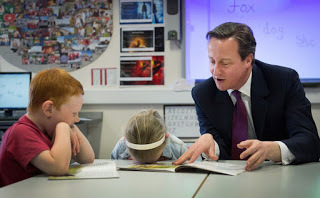
Any topic being discussed – whether hidden inside a story or a narrative that explains a concept – space, dinosaurs, trucks need to appeal to the child first and foremost. Then it needs to engage the adult reader too. If it manages both, then of course reading it over and over again becomes less of a chore.
So as a writer in this complex political world, I have two voters for every read – a contemporary voter who hopefully would vote in the next election (by the looks of it, we might have it regularly like an annual summer event) and a child voter who is the future of this nation. This captive audience is looking for a story. A story that they can enjoy, laugh with, think about and perhaps learn from. A story that doesn’t beat the moral over the reader’s head but through its nuanced plot elements, leads us to the inevitable but surprising ending.
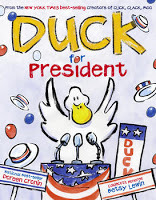 As I watched the election results trickle by, as the nation rejoiced of a hung parliament, I realised I have an obligation to stand up and tell stories that
As I watched the election results trickle by, as the nation rejoiced of a hung parliament, I realised I have an obligation to stand up and tell stories that
a) promote equality, diversity, empathy and compassion
b) children of all colour, abilities and gender in a positive light
c) give us hope instead of despair; joy in the face of adversity.
Many of us remember the books we read as kids. Many of us have learnt some crucial things about life from books. So what better way to equip the voters of tomorrow? What better way to prepare the minds of young readers than give them stories that they can apply in real life that will bring about a better society for everyone?
 Children’s writers have an important role in these interesting times. Whether we are talking about underpants or wishing the rabbit good night, we need to make our characters stand up for something. They need to find their way in these murky times through stories we tell and stories we equip them to tell.
Children’s writers have an important role in these interesting times. Whether we are talking about underpants or wishing the rabbit good night, we need to make our characters stand up for something. They need to find their way in these murky times through stories we tell and stories we equip them to tell.
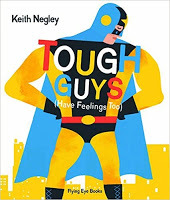 This is the time to bring out stories that empower our children with skills and sensitivity to live in an integrated society, where we do not fear “the other” and “the unknown.” And the good news is many writers are already doing this. There are books out there that show us “others” are not different. Like Siddhartha Mukherjee says in his book The Gene – An Intimate History, we are more similar than different as human beings.
This is the time to bring out stories that empower our children with skills and sensitivity to live in an integrated society, where we do not fear “the other” and “the unknown.” And the good news is many writers are already doing this. There are books out there that show us “others” are not different. Like Siddhartha Mukherjee says in his book The Gene – An Intimate History, we are more similar than different as human beings.
On 13th June, Empathy Lab UK initiated a new celebration called EmpathyDay and on that day, we all tweeted our recommended reads. I’ve started collecting them all here. If you know of a book that inspires empathy, promotes togetherness and brings us together, then do post in the comments below or tweet it out with hashtag #ReadForEmpathy.
Let’s help raise better citizens for tomorrow.
 Chitra Soundar is a closet clown, consummate liar, writer and storyteller. Find out more at www.chitrasoundar.com or follow her on Twitter at @csoundar.
Chitra Soundar is a closet clown, consummate liar, writer and storyteller. Find out more at www.chitrasoundar.com or follow her on Twitter at @csoundar.

How does a children’s book writer get involved? My readers are wee people who do not understand constitution or right to vote. Many are perhaps not even potty trained. What could I possibly do to bring about change?
Read an interesting discussion in the New York Times - that discusses this very topic.
Good picture books have multiple layers and meanings. While it deals with a child’s emotion in a child’s world from the point of view of a child, it also has an adult reader, often. Many picture books are read aloud by sleepy-eyed parents, novice aunts and uncles doing bedtime as a novelty or grandparents who are amazed at how much books have changed over the years.

Any topic being discussed – whether hidden inside a story or a narrative that explains a concept – space, dinosaurs, trucks need to appeal to the child first and foremost. Then it needs to engage the adult reader too. If it manages both, then of course reading it over and over again becomes less of a chore.
So as a writer in this complex political world, I have two voters for every read – a contemporary voter who hopefully would vote in the next election (by the looks of it, we might have it regularly like an annual summer event) and a child voter who is the future of this nation. This captive audience is looking for a story. A story that they can enjoy, laugh with, think about and perhaps learn from. A story that doesn’t beat the moral over the reader’s head but through its nuanced plot elements, leads us to the inevitable but surprising ending.
 As I watched the election results trickle by, as the nation rejoiced of a hung parliament, I realised I have an obligation to stand up and tell stories that
As I watched the election results trickle by, as the nation rejoiced of a hung parliament, I realised I have an obligation to stand up and tell stories thata) promote equality, diversity, empathy and compassion
b) children of all colour, abilities and gender in a positive light
c) give us hope instead of despair; joy in the face of adversity.
Many of us remember the books we read as kids. Many of us have learnt some crucial things about life from books. So what better way to equip the voters of tomorrow? What better way to prepare the minds of young readers than give them stories that they can apply in real life that will bring about a better society for everyone?
 Children’s writers have an important role in these interesting times. Whether we are talking about underpants or wishing the rabbit good night, we need to make our characters stand up for something. They need to find their way in these murky times through stories we tell and stories we equip them to tell.
Children’s writers have an important role in these interesting times. Whether we are talking about underpants or wishing the rabbit good night, we need to make our characters stand up for something. They need to find their way in these murky times through stories we tell and stories we equip them to tell. This is the time to bring out stories that empower our children with skills and sensitivity to live in an integrated society, where we do not fear “the other” and “the unknown.” And the good news is many writers are already doing this. There are books out there that show us “others” are not different. Like Siddhartha Mukherjee says in his book The Gene – An Intimate History, we are more similar than different as human beings.
This is the time to bring out stories that empower our children with skills and sensitivity to live in an integrated society, where we do not fear “the other” and “the unknown.” And the good news is many writers are already doing this. There are books out there that show us “others” are not different. Like Siddhartha Mukherjee says in his book The Gene – An Intimate History, we are more similar than different as human beings. On 13th June, Empathy Lab UK initiated a new celebration called EmpathyDay and on that day, we all tweeted our recommended reads. I’ve started collecting them all here. If you know of a book that inspires empathy, promotes togetherness and brings us together, then do post in the comments below or tweet it out with hashtag #ReadForEmpathy.
Let’s help raise better citizens for tomorrow.
 Chitra Soundar is a closet clown, consummate liar, writer and storyteller. Find out more at www.chitrasoundar.com or follow her on Twitter at @csoundar.
Chitra Soundar is a closet clown, consummate liar, writer and storyteller. Find out more at www.chitrasoundar.com or follow her on Twitter at @csoundar.
Published on June 18, 2017 23:00
Responding to a Call to Action by Chitra Soundar
We’re living in strange times – where dystopia is no longer confined to the pages of a novel. Around us we find fear and insecurity, differences and intolerances turn into political ideology and public policy.

How does a children’s book writer get involved? My readers are wee people who do not understand constitution or right to vote. Many are perhaps not even potty trained. What could I possibly do to bring about change?
Read an interesting discussion in the New York Times - that discusses this very topic.
Good picture books have multiple layers and meanings. While it deals with a child’s emotion in a child’s world from the point of view of a child, it also has an adult reader, often. Many picture books are read aloud by sleepy-eyed parents, novice aunts and uncles doing bedtime as a novelty or grandparents who are amazed at how much books have changed over the years.

Any topic being discussed – whether hidden inside a story or a narrative that explains a concept – space, dinosaurs, trucks need to appeal to the child first and foremost. Then it needs to engage the adult reader too. If it manages both, then of course reading it over and over again becomes less of a chore.
So as a writer in this complex political world, I have two voters for every read – a contemporary voter who hopefully would vote in the next election (by the looks of it, we might have it regularly like an annual summer event) and a child voter who is the future of this nation. This captive audience is looking for a story. A story that they can enjoy, laugh with, think about and perhaps learn from. A story that doesn’t beat the moral over the reader’s head but through its nuanced plot elements, leads us to the inevitable but surprising ending.
 As I watched the election results trickle by, as the nation rejoiced of a hung parliament, I realised I have an obligation to stand up and tell stories that
As I watched the election results trickle by, as the nation rejoiced of a hung parliament, I realised I have an obligation to stand up and tell stories that
a) promote equality, diversity, empathy and compassion
b) children of all colour, abilities and gender in a positive light
c) give us hope instead of despair; joy in the face of adversity.
Many of us remember the books we read as kids. Many of us have learnt some crucial things about life from books. So what better way to equip the voters of tomorrow? What better way to prepare the minds of young readers than give them stories that they can apply in real life that will bring about a better society for everyone?
 Children’s writers have an important role in these interesting times. Whether we are talking about underpants or wishing the rabbit good night, we need to make our characters stand up for something. They need to find their way in these murky times through stories we tell and stories we equip them to tell.
Children’s writers have an important role in these interesting times. Whether we are talking about underpants or wishing the rabbit good night, we need to make our characters stand up for something. They need to find their way in these murky times through stories we tell and stories we equip them to tell.
 This is the time to bring out stories that empower our children with skills and sensitivity to live in an integrated society, where we do not fear “the other” and “the unknown.” And the good news is many writers are already doing this. There are books out there that show us “others” are not different. Like Siddhartha Mukherjee says in his book The Gene – An Intimate History, we are more similar than different as human beings.
This is the time to bring out stories that empower our children with skills and sensitivity to live in an integrated society, where we do not fear “the other” and “the unknown.” And the good news is many writers are already doing this. There are books out there that show us “others” are not different. Like Siddhartha Mukherjee says in his book The Gene – An Intimate History, we are more similar than different as human beings.
On 13th June, Empathy Lab UK initiated a new celebration called EmpathyDay and on that day, we all tweeted our recommended reads. I’ve started collecting them all here. If you know of a book that inspires empathy, promotes togetherness and brings us together, then do post in the comments below or tweet it out with hashtag #ReadForEmpathy.
Let’s help raise better citizens for tomorrow.
 Chitra Soundar is a closet clown, consummate liar, writer and storyteller. Find out more at www.chitrasoundar.com or follow her on Twitter at @csoundar.
Chitra Soundar is a closet clown, consummate liar, writer and storyteller. Find out more at www.chitrasoundar.com or follow her on Twitter at @csoundar.

How does a children’s book writer get involved? My readers are wee people who do not understand constitution or right to vote. Many are perhaps not even potty trained. What could I possibly do to bring about change?
Read an interesting discussion in the New York Times - that discusses this very topic.
Good picture books have multiple layers and meanings. While it deals with a child’s emotion in a child’s world from the point of view of a child, it also has an adult reader, often. Many picture books are read aloud by sleepy-eyed parents, novice aunts and uncles doing bedtime as a novelty or grandparents who are amazed at how much books have changed over the years.

Any topic being discussed – whether hidden inside a story or a narrative that explains a concept – space, dinosaurs, trucks need to appeal to the child first and foremost. Then it needs to engage the adult reader too. If it manages both, then of course reading it over and over again becomes less of a chore.
So as a writer in this complex political world, I have two voters for every read – a contemporary voter who hopefully would vote in the next election (by the looks of it, we might have it regularly like an annual summer event) and a child voter who is the future of this nation. This captive audience is looking for a story. A story that they can enjoy, laugh with, think about and perhaps learn from. A story that doesn’t beat the moral over the reader’s head but through its nuanced plot elements, leads us to the inevitable but surprising ending.
 As I watched the election results trickle by, as the nation rejoiced of a hung parliament, I realised I have an obligation to stand up and tell stories that
As I watched the election results trickle by, as the nation rejoiced of a hung parliament, I realised I have an obligation to stand up and tell stories thata) promote equality, diversity, empathy and compassion
b) children of all colour, abilities and gender in a positive light
c) give us hope instead of despair; joy in the face of adversity.
Many of us remember the books we read as kids. Many of us have learnt some crucial things about life from books. So what better way to equip the voters of tomorrow? What better way to prepare the minds of young readers than give them stories that they can apply in real life that will bring about a better society for everyone?
 Children’s writers have an important role in these interesting times. Whether we are talking about underpants or wishing the rabbit good night, we need to make our characters stand up for something. They need to find their way in these murky times through stories we tell and stories we equip them to tell.
Children’s writers have an important role in these interesting times. Whether we are talking about underpants or wishing the rabbit good night, we need to make our characters stand up for something. They need to find their way in these murky times through stories we tell and stories we equip them to tell. This is the time to bring out stories that empower our children with skills and sensitivity to live in an integrated society, where we do not fear “the other” and “the unknown.” And the good news is many writers are already doing this. There are books out there that show us “others” are not different. Like Siddhartha Mukherjee says in his book The Gene – An Intimate History, we are more similar than different as human beings.
This is the time to bring out stories that empower our children with skills and sensitivity to live in an integrated society, where we do not fear “the other” and “the unknown.” And the good news is many writers are already doing this. There are books out there that show us “others” are not different. Like Siddhartha Mukherjee says in his book The Gene – An Intimate History, we are more similar than different as human beings. On 13th June, Empathy Lab UK initiated a new celebration called EmpathyDay and on that day, we all tweeted our recommended reads. I’ve started collecting them all here. If you know of a book that inspires empathy, promotes togetherness and brings us together, then do post in the comments below or tweet it out with hashtag #ReadForEmpathy.
Let’s help raise better citizens for tomorrow.
 Chitra Soundar is a closet clown, consummate liar, writer and storyteller. Find out more at www.chitrasoundar.com or follow her on Twitter at @csoundar.
Chitra Soundar is a closet clown, consummate liar, writer and storyteller. Find out more at www.chitrasoundar.com or follow her on Twitter at @csoundar.
Published on June 18, 2017 23:00
June 11, 2017
My Prickly Friends • Lynne Garner
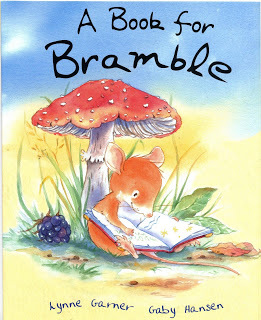 A book about the friendship between a
A book about the friendship between a mouse and a hedgehog. If you're a long term follower of The Picture Book Den then you'll know I love hedgehogs. So much so that I've been rescuing them (on a very small scale from a 6' x 8' shed in my back garden) for the last 25 years (Herts Hogline). They're so much a part of my life that they even creep into my writing. In fact my first picture book 'A Book For Bramble' was inspired by them. I've also written a great many non-fiction magazine features about them and this year they star in my latest collect of 8 retold traditional tales ( Hedgehog of Moon Meadow Farm ) and my latest picture book written as co-author with hypnotist Chris Caress called 'Harvey's Big Sleep.'
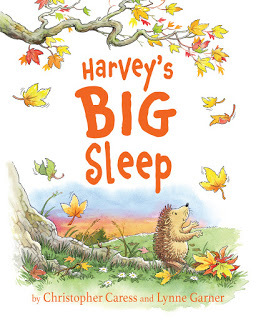 A picture booked aimed at helping
A picture booked aimed at helpingchildren to sleep
As I write this post and if you're reading this within a couple of weeks of my pressing the publish button I'm hand rearing six hoglets. So rather than tell you something about picture books I've decided to do something a little different. I'm going to turn you all into hedgehog geeks, so you'll know exactly what to do to help our dwindling hedgehog population. Quick fact: hedgehog numbers in the 1950s-60s were an estimated 30 million. Today that has plummeted to 1 million (a faster loss than the loss of the worlds tigers). So here are a few ways you can help our hogs:
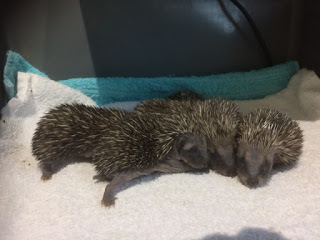 There are 6, promise. One is hidden under it's siblings.
There are 6, promise. One is hidden under it's siblings.The white marks are tipex, so I can tell who is who.
If you have a pond with steep sides then fit a ramp.Keep netting at least 15cm (6") off the ground.Leave out food and water. This can be special hedgehog food, tinned cat/dog food (non-fishy flavours) but NEVER bread and milk. To avoid cats eating the food buy or make a feeding station.Always check under hedges and in long grass before cutting.Pick up elastic bands or hair bands, cut up and put into a bin. These and prickles don't mix well.To avoid hedgehogs making a nest in your shed/garage, stable or tack room keep the door closed at all times.Do not use slug pellets; find safer alternatives.Always check a bonfire before you light it.Provide shelter by buying or making a hog home. Hedgehogs out during the day are highly likely to need medical help a.s.a.p. so contact British Hedgehog Preservation Society for advice.Never treat for fleas; pet flea solutions are lethal to hedgehogs.During autumn and winter small hedgehogs (under 600 grams) are too small to hibernate, so need to be rescued.
As this is the height of the breeding season the BHPS provide the following advice on nesting females and hoglets:
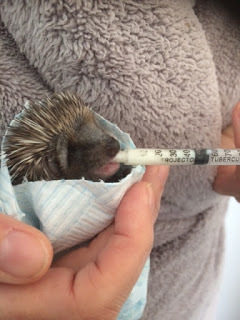 The first feed of the day - hence still in PJsIf you accidentally disturb a nest try to restore it quickly and without too much fuss. Check with a piece of screwed up piece of paper to see whether mum is returning, they all react differently, some move the babies over several days, a few have been known to kill them whilst others just abandon them. If the nest is in a place where it cannot be left catch the mother before the babies as she will be the most mobile. Place her in high sided box with some of the bedding from the nest and then slip her babies in with her. Contact the BHPS to find a local contact who can advise and if necessary take in the family. Do not release them somewhere yourself as mum is very likely to abandon them, given the amount of disturbance she has endured.
The first feed of the day - hence still in PJsIf you accidentally disturb a nest try to restore it quickly and without too much fuss. Check with a piece of screwed up piece of paper to see whether mum is returning, they all react differently, some move the babies over several days, a few have been known to kill them whilst others just abandon them. If the nest is in a place where it cannot be left catch the mother before the babies as she will be the most mobile. Place her in high sided box with some of the bedding from the nest and then slip her babies in with her. Contact the BHPS to find a local contact who can advise and if necessary take in the family. Do not release them somewhere yourself as mum is very likely to abandon them, given the amount of disturbance she has endured.Last but not least if you're concerned about your local visiting hedgehog, need advice or find an orphaned, sick or injured hedgehog contact the BHPS (01584 890801) they can give general advice and perhaps details of a local hedgehog rehabilitator that you can contact.
If you've reached this far, thanks for reading and please do share this far and wide. Hedgehogs need as many friends as they can get.
Regards
Lynne
Now for a blatant plug:
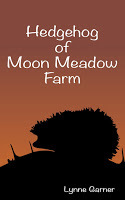 My latest collection of short stories featuring is available on Amazon in eBook format and as a paperback.
My latest collection of short stories featuring is available on Amazon in eBook format and as a paperback.Hedgehog of Moon Meadow Farm
UK - ebook and paperback
US - ebook and paperback
Published on June 11, 2017 22:30
June 4, 2017
Fairy tale influences on picture book writing • Jane Clarke
I loved fairy tales when I was young, and still hear the echoes when I’m writing picture book texts - especially the fairy tale detective twists I’m currently working on. Here’s what I've absorbed from them, with illustrations by Loretta Schauer from the first two books in the Sky Private Eye series:
Animals can talk and each character has a distinctive voice.I can replay in my head over a half century later, my long-gone dad’s mock-scary growling of the big bad wolf!
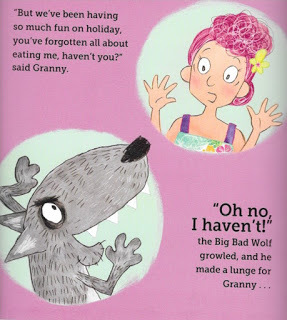
A rhythm and a rhyme are fun for the reader (or listener) to join in with. The gingerbread boy run, run, runs as fast as he can, the billy goats gruff, trip-trap over a bridge, the wicked queen asks 'mirror, mirror on the wall, who is the first of them all?'.
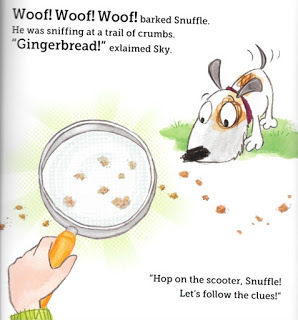 There a lot of woofing to be done, too.
There a lot of woofing to be done, too.
The rule of three makes for satisfying reading. Characters frequently appear in threes (Three Little Pigs, Three Billy Goats Gruff, Three Bears) or say or do things three times (there queen gets three guesses at Rumpelstiltskin's name, Goldilocks tries out 3 chairs and 3 beds and three bowls of porridge, the big bad wolf huffs and puffs and tries to blow down three houses each belonging to the thee pigs).
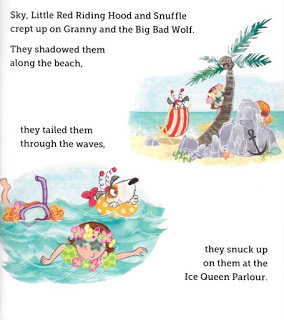 rule of three text in action.
rule of three text in action.
There are moments of peril, but the ending is reassuring.
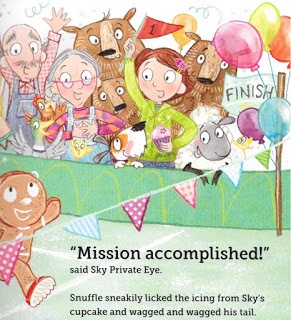
I remember fairy tales very fondly as part of my happy childhood. It was only much later that I realised that fairy tales were passed down orally through the generations before they were written down - and that a lot of Grimm's tales are in origin pretty grim! Call me a wimp, but I still prefer for the big bad wolf not to be exterminated.
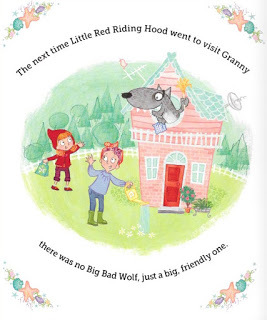
It's great fun to play with new twists on fairytales, and I feel privileged to join the ranks of the picture book authors who have done this in so many different ways, including, of course Picture Book Den's Abie Longstaff whose Fairytale Hairdresser series is such a success.
As grandma of 3 granddaughters, Jane's aware that female characters in fairy stories can be a bit passive/on the lookout for a prince, so Sky Private Eye is a get up and go fairytale detective, ably assisted by her dog Snuffle. Their first two adventures are out now.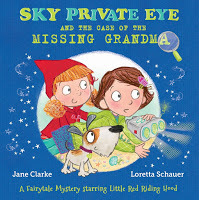
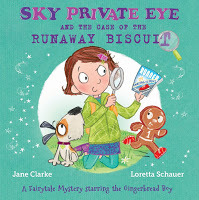
There are some Sky Private Eye activity sheets to download free on the Picture Book Den downloads page, too!
Animals can talk and each character has a distinctive voice.I can replay in my head over a half century later, my long-gone dad’s mock-scary growling of the big bad wolf!

A rhythm and a rhyme are fun for the reader (or listener) to join in with. The gingerbread boy run, run, runs as fast as he can, the billy goats gruff, trip-trap over a bridge, the wicked queen asks 'mirror, mirror on the wall, who is the first of them all?'.
 There a lot of woofing to be done, too.
There a lot of woofing to be done, too.The rule of three makes for satisfying reading. Characters frequently appear in threes (Three Little Pigs, Three Billy Goats Gruff, Three Bears) or say or do things three times (there queen gets three guesses at Rumpelstiltskin's name, Goldilocks tries out 3 chairs and 3 beds and three bowls of porridge, the big bad wolf huffs and puffs and tries to blow down three houses each belonging to the thee pigs).
 rule of three text in action.
rule of three text in action.There are moments of peril, but the ending is reassuring.

I remember fairy tales very fondly as part of my happy childhood. It was only much later that I realised that fairy tales were passed down orally through the generations before they were written down - and that a lot of Grimm's tales are in origin pretty grim! Call me a wimp, but I still prefer for the big bad wolf not to be exterminated.

It's great fun to play with new twists on fairytales, and I feel privileged to join the ranks of the picture book authors who have done this in so many different ways, including, of course Picture Book Den's Abie Longstaff whose Fairytale Hairdresser series is such a success.
As grandma of 3 granddaughters, Jane's aware that female characters in fairy stories can be a bit passive/on the lookout for a prince, so Sky Private Eye is a get up and go fairytale detective, ably assisted by her dog Snuffle. Their first two adventures are out now.


There are some Sky Private Eye activity sheets to download free on the Picture Book Den downloads page, too!
Published on June 04, 2017 22:30
Fairy tale influences on picture book writing by Jane Clarke
I loved fairy tales when I was young, and still hear the echoes when I’m writing picture book texts - especially the fairy tale detective twists I’m currently working on. Here’s what I've absorbed from them, with illustrations by Loretta Schauer from the first two books in the Sky Private Eye series:
Animals can talk and each character has a distinctive voice.I can replay in my head over a half century later, my long-gone dad’s mock-scary growling of the big bad wolf!

A rhythm and a rhyme are fun for the reader (or listener) to join in with. The gingerbread boy run, run, runs as fast as he can, the billy goats gruff, trip-trap over a bridge, the wicked queen asks 'mirror, mirror on the wall, who is the first of them all?'.
 There a lot of woofing to be done, too.
There a lot of woofing to be done, too.
The rule of three makes for satisfying reading. Characters frequently appear in threes (Three Little Pigs, Three Billy Goats Gruff, Three Bears) or say or do things three times (there queen gets three guesses at Rumpelstiltskin's name, Goldilocks tries out 3 chairs and 3 beds and three bowls of porridge, the big bad wolf huffs and puffs and tries to blow down three houses each belonging to the thee pigs).
 rule of three text in action.
rule of three text in action.
There are moments of peril, but the ending is reassuring.

I remember fairy tales very fondly as part of my happy childhood. It was only much later that I realised that fairy tales were passed down orally through the generations before they were written down - and that a lot of Grimm's tales are in origin pretty grim! Call me a wimp, but I still prefer for the big bad wolf not to be exterminated.

It's great fun to play with new twists on fairytales, and I feel privileged to join the ranks of the picture book authors who have done this in so many different ways, including, of course Picture Book Den's Abie Longstaff whose Fairytale Hairdresser series is such a success.
As grandma of 3 granddaughters, Jane's aware that female characters in fairy stories can be a bit passive/on the lookout for a prince, so Sky Private Eye is a get up and go fairytale detective, ably assisted by her dog Snuffle. Their first two adventures are out now.

There are some Sky Private Eye activity sheets to download free on the Picture Book Den downloads page, too!
Animals can talk and each character has a distinctive voice.I can replay in my head over a half century later, my long-gone dad’s mock-scary growling of the big bad wolf!

A rhythm and a rhyme are fun for the reader (or listener) to join in with. The gingerbread boy run, run, runs as fast as he can, the billy goats gruff, trip-trap over a bridge, the wicked queen asks 'mirror, mirror on the wall, who is the first of them all?'.
 There a lot of woofing to be done, too.
There a lot of woofing to be done, too.The rule of three makes for satisfying reading. Characters frequently appear in threes (Three Little Pigs, Three Billy Goats Gruff, Three Bears) or say or do things three times (there queen gets three guesses at Rumpelstiltskin's name, Goldilocks tries out 3 chairs and 3 beds and three bowls of porridge, the big bad wolf huffs and puffs and tries to blow down three houses each belonging to the thee pigs).
 rule of three text in action.
rule of three text in action.There are moments of peril, but the ending is reassuring.

I remember fairy tales very fondly as part of my happy childhood. It was only much later that I realised that fairy tales were passed down orally through the generations before they were written down - and that a lot of Grimm's tales are in origin pretty grim! Call me a wimp, but I still prefer for the big bad wolf not to be exterminated.

It's great fun to play with new twists on fairytales, and I feel privileged to join the ranks of the picture book authors who have done this in so many different ways, including, of course Picture Book Den's Abie Longstaff whose Fairytale Hairdresser series is such a success.
As grandma of 3 granddaughters, Jane's aware that female characters in fairy stories can be a bit passive/on the lookout for a prince, so Sky Private Eye is a get up and go fairytale detective, ably assisted by her dog Snuffle. Their first two adventures are out now.


There are some Sky Private Eye activity sheets to download free on the Picture Book Den downloads page, too!
Published on June 04, 2017 22:30
May 29, 2017
LOVE A BOOK? SHARE A BOOK • Michelle Robinson
It’s a wonderful time to be a reader. Apart from if you're reading this post - I can't get the font size to behave, apologies. Anyway...
There's talk of this being a 'new golden age' of children's literature. Looking at the shelves, I think that might be right.
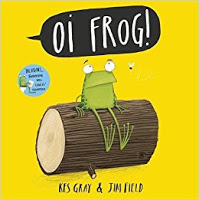 New and established talents are creating some real gems. Sadly many adults buying books for children still like to shop 'safely' and pick up books by the same old household names - the school I volunteer at has a thing for Just William. But pick up something brand new and you're in equally safe hands.
New and established talents are creating some real gems. Sadly many adults buying books for children still like to shop 'safely' and pick up books by the same old household names - the school I volunteer at has a thing for Just William. But pick up something brand new and you're in equally safe hands.
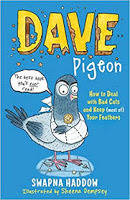 Today's authors and illustrators were raised on the classics. We've done our homework, learned from the masters plus been influenced by new sources and a changing world. We work with publishers who know what makes books great and who can't afford to create rubbish.
Today's authors and illustrators were raised on the classics. We've done our homework, learned from the masters plus been influenced by new sources and a changing world. We work with publishers who know what makes books great and who can't afford to create rubbish.
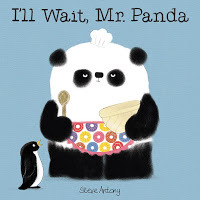
Roald Dahl will always be there, ditto Enid Blyton and Beatrix Potter. Classics are amazeballs, I agree! Nostalgia's nice! But how about discovering something fresh?
Have you seen what Philip Reeve and Sarah McIntyre are producing?! Alex T Smith? Will Mabbitt? Jonny Duddle? Swapna Haddow and Sheena Dempsey? Kes Gray and Jim Field? Laura James and Eglantine Ceulemans? I could go on FOREVER - but it's much more fun to pop to a book shop and browse.
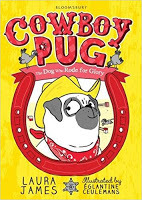 There’s a book to turn every reluctant reader on to reading. There’s a book to help any reader suffering from Beast Quest/Rainbow Magic fatigue. The industry is even beginning to wake up to the fact that there need to be books in which every child can recognise themselves. ...Pity about the lack of libraries to connect children to any of these books, AND the lack of column inches dedicated to children's reading... but that’s another blog post entirely.
There’s a book to turn every reluctant reader on to reading. There’s a book to help any reader suffering from Beast Quest/Rainbow Magic fatigue. The industry is even beginning to wake up to the fact that there need to be books in which every child can recognise themselves. ...Pity about the lack of libraries to connect children to any of these books, AND the lack of column inches dedicated to children's reading... but that’s another blog post entirely.
As this is my last post for the Picture Book Den I'd like to use it to ask a favour. If you love children's books, please SHOUT ABOUT THEM.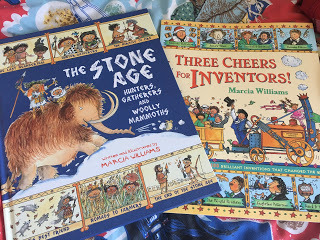
LOVE A BOOK, SHARE A BOOK
Try something new!Spread the word about great books!Use and support libraries! Give books as gifts!Support independent book shops!Tell people about books you’ve enjoyed!Donate a book to your local school library!
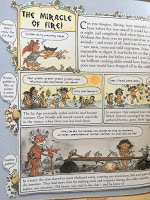
Whose books have you fallen in love with lately? Please share a recommendation in the comments thread below - new or old. I’ll kick things off: I was struggling to find non-fiction history books that my son liked. He loves Horrible Histories on TV but really doesn't enjoy the books (which still seem to dominate the market...).
All hail MARCIA WILLIAMS! Marcia writes excellent non-fiction told in comic strip style. We're now binge reading her books and I'll be investing in a set for the school library at Christmas. Hooray for varied book shelves where you can still make new discoveries.
Please share a book below - no self promotion, please. Thanks so much - see you in the children's section!____________________________
 Michelle Robinson is a best-selling picture book author. Her latest, ‘THE HAT THAT ZACK LOVES’, is illustrated by Robert Reader and publishes with Puffin in July 2017.
Michelle Robinson is a best-selling picture book author. Her latest, ‘THE HAT THAT ZACK LOVES’, is illustrated by Robert Reader and publishes with Puffin in July 2017.
p.p1 {margin: 0.0px 0.0px 0.0px 0.0px; font: 11.0px Helvetica; color: #000000; -webkit-text-stroke: #000000; min-height: 13.0px} p.p2 {margin: 0.0px 0.0px 0.0px 0.0px; font: 11.0px Helvetica; color: #000000; -webkit-text-stroke: #000000} li.li2 {margin: 0.0px 0.0px 0.0px 0.0px; font: 11.0px Helvetica; color: #000000; -webkit-text-stroke: #000000} span.s1 {font-kerning: none} span.s2 {font: 13.2px Helvetica} ul.ul1 {list-style-type: disc}
p.p1 {margin: 0.0px 0.0px 0.0px 0.0px; font: 11.0px Helvetica; color: #000000; -webkit-text-stroke: #000000; min-height: 13.0px} p.p2 {margin: 0.0px 0.0px 0.0px 0.0px; font: 11.0px Helvetica; color: #000000; -webkit-text-stroke: #000000} li.li2 {margin: 0.0px 0.0px 0.0px 0.0px; font: 11.0px Helvetica; color: #000000; -webkit-text-stroke: #000000} span.s1 {font-kerning: none} span.s2 {font: 13.2px Helvetica} ul.ul1 {list-style-type: disc}
x
There's talk of this being a 'new golden age' of children's literature. Looking at the shelves, I think that might be right.
 New and established talents are creating some real gems. Sadly many adults buying books for children still like to shop 'safely' and pick up books by the same old household names - the school I volunteer at has a thing for Just William. But pick up something brand new and you're in equally safe hands.
New and established talents are creating some real gems. Sadly many adults buying books for children still like to shop 'safely' and pick up books by the same old household names - the school I volunteer at has a thing for Just William. But pick up something brand new and you're in equally safe hands. Today's authors and illustrators were raised on the classics. We've done our homework, learned from the masters plus been influenced by new sources and a changing world. We work with publishers who know what makes books great and who can't afford to create rubbish.
Today's authors and illustrators were raised on the classics. We've done our homework, learned from the masters plus been influenced by new sources and a changing world. We work with publishers who know what makes books great and who can't afford to create rubbish. 
Roald Dahl will always be there, ditto Enid Blyton and Beatrix Potter. Classics are amazeballs, I agree! Nostalgia's nice! But how about discovering something fresh?
Have you seen what Philip Reeve and Sarah McIntyre are producing?! Alex T Smith? Will Mabbitt? Jonny Duddle? Swapna Haddow and Sheena Dempsey? Kes Gray and Jim Field? Laura James and Eglantine Ceulemans? I could go on FOREVER - but it's much more fun to pop to a book shop and browse.
 There’s a book to turn every reluctant reader on to reading. There’s a book to help any reader suffering from Beast Quest/Rainbow Magic fatigue. The industry is even beginning to wake up to the fact that there need to be books in which every child can recognise themselves. ...Pity about the lack of libraries to connect children to any of these books, AND the lack of column inches dedicated to children's reading... but that’s another blog post entirely.
There’s a book to turn every reluctant reader on to reading. There’s a book to help any reader suffering from Beast Quest/Rainbow Magic fatigue. The industry is even beginning to wake up to the fact that there need to be books in which every child can recognise themselves. ...Pity about the lack of libraries to connect children to any of these books, AND the lack of column inches dedicated to children's reading... but that’s another blog post entirely.As this is my last post for the Picture Book Den I'd like to use it to ask a favour. If you love children's books, please SHOUT ABOUT THEM.

LOVE A BOOK, SHARE A BOOK
Try something new!Spread the word about great books!Use and support libraries! Give books as gifts!Support independent book shops!Tell people about books you’ve enjoyed!Donate a book to your local school library!

Whose books have you fallen in love with lately? Please share a recommendation in the comments thread below - new or old. I’ll kick things off: I was struggling to find non-fiction history books that my son liked. He loves Horrible Histories on TV but really doesn't enjoy the books (which still seem to dominate the market...).
All hail MARCIA WILLIAMS! Marcia writes excellent non-fiction told in comic strip style. We're now binge reading her books and I'll be investing in a set for the school library at Christmas. Hooray for varied book shelves where you can still make new discoveries.
Please share a book below - no self promotion, please. Thanks so much - see you in the children's section!____________________________
 Michelle Robinson is a best-selling picture book author. Her latest, ‘THE HAT THAT ZACK LOVES’, is illustrated by Robert Reader and publishes with Puffin in July 2017.
Michelle Robinson is a best-selling picture book author. Her latest, ‘THE HAT THAT ZACK LOVES’, is illustrated by Robert Reader and publishes with Puffin in July 2017. p.p1 {margin: 0.0px 0.0px 0.0px 0.0px; font: 11.0px Helvetica; color: #000000; -webkit-text-stroke: #000000; min-height: 13.0px} p.p2 {margin: 0.0px 0.0px 0.0px 0.0px; font: 11.0px Helvetica; color: #000000; -webkit-text-stroke: #000000} li.li2 {margin: 0.0px 0.0px 0.0px 0.0px; font: 11.0px Helvetica; color: #000000; -webkit-text-stroke: #000000} span.s1 {font-kerning: none} span.s2 {font: 13.2px Helvetica} ul.ul1 {list-style-type: disc}
p.p1 {margin: 0.0px 0.0px 0.0px 0.0px; font: 11.0px Helvetica; color: #000000; -webkit-text-stroke: #000000; min-height: 13.0px} p.p2 {margin: 0.0px 0.0px 0.0px 0.0px; font: 11.0px Helvetica; color: #000000; -webkit-text-stroke: #000000} li.li2 {margin: 0.0px 0.0px 0.0px 0.0px; font: 11.0px Helvetica; color: #000000; -webkit-text-stroke: #000000} span.s1 {font-kerning: none} span.s2 {font: 13.2px Helvetica} ul.ul1 {list-style-type: disc}
x
Published on May 29, 2017 23:00



